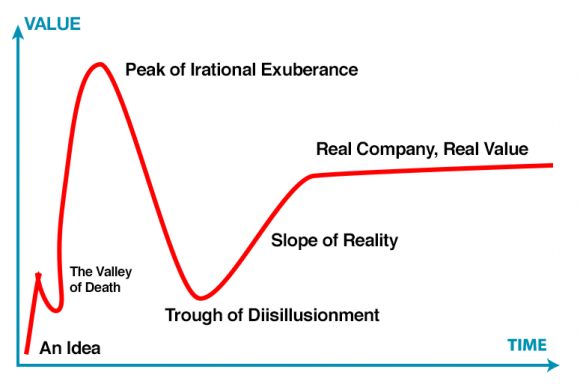
Last week I wrote about the ancient system of Bills of Exchange and how useful they were for sellers to get paid sooner than 30, 60, or 90 days after the sale.
A 21st Century systemic solution to replicate these benefits would be a marketplace that sells and trades Future Dollars (denoted as F$).
A future dollar is a promise to deliver a real dollar ($) in a specific number of days. With this system in place a buyer would write a purchase order as they do today, but then instead of promising to pay Net-30, they would pay using F30$, Future Dollars maturing in 30 days.
Unbundling
A Bill of Exchange or Purchase Order is really two bundled contracts. First is the transfer of goods from buyer to seller and second the promise to pay in the future, from seller to buyer. A Future Dollar is just the latter half of the contract. One that recreates the liquidity of those old Bills of Exchange, but in a scalable system.
F30$, F29$, … F1$, $
Every new Future Dollar has a maturity date, listed as a countdown of days to maturity. If the agreement between buyer and seller is paying in 30 days, then the new Future Dollars created by that contract start as F30$, automatically becoming F29$ the next day, F28$ the day after that, and 30 days later are real, spendable dollars (presuming the buyer pays on time).
Late Fees
Like Bills of Exchange, Future Dollars include terms for interest and late fees if real dollars are not delivered as promised.
Maturity
It is expected that most buyers will close out their Future Dollars on or before their maturity date. For those that don’t, the Future Dollars become Future-Future Dollars, eventually to be collected with interest and late fees. More on this later.
Why would the buyers pay? Because if they don’t, their accounts will automatically be tagged as late payers for every seller to see, and bad actors can lose the right to pay in Future Dollars completely.
Discounts
What sets this system apart from purchase orders, bank loans, the credit card network is the market for discounts.
This market brings back the historic idea of buying discounted Bills of Exchange, but better. In this market, all the Future Dollars are fungible, or close enough to act as fungible. It doesn’t matter if the goods bought were tea or silk or sewage sludge. Sellers list any of their Future Dollars on the market and speculators can bid on any Future Dollars, with separate auctions for each countdown-to-maturity and other factors.
The result is similar to the tea seller in 1820 selling their Bill of Exchange to a local bank. For example, a Botswanan company in 2022 selling honey to a Namibian buyer can be paid F30$100,000 (i.e., 100,000 Future Dollars maturing in 30 days), and anytime in the next 30 days the seller can list all of some of those 100,000 F$s on the market, sold at a discount, turning “accounts receivable” into spendable dollars. Thus, rather than waiting 30 days (or more) to be paid $100,000 and rather than drawing down an overdraft account or line of credit at the bank, the seller can have most of that $100,000 in cash by selling the F$s at an auctioned price in a large, liquid market.
The price per auction will undoubtedly depend on the time to maturity, along with the state of the economy. In general, F1$s will trade at a higher price than F30$s (i.e., Future Dollars maturing tomorrow will cost more than Future Dollars maturing in 30 days), which themselves trade at a higher price than F90$s.
The timing on when to sell any or all F$s is in the control of the sellers. The sooner the seller needs real $s, the higher the expected discount and the lower the sales price. Similarly, the price that a seller lists their F$s is under their control as well. The F$ auctions act just like a stock market with a book of bids and asks, a spread, and trades taking place when a buyer’s price matches a seller’s price.
Transparency
As a centralized marketplace, it is possible to list every Future Dollar created, to track which Future Dollars were paid on time, which were paid late, and which were never paid. As a digital platform, this public ledger can be pseudo-anonymous, protecting the public identity of the buyers and seller, but with the marketplace knowing real identities, using know-your-customer-compliant (KYC) methods outside of public view.
Ratings
With a public ledger, it is possible to automate a system of credit ratings for buyers. Buyers who always pay on time receive an A rating. Buyers with some late payments but with all interest and penalties paid receive a B rating. Buyers with late payments and penalties in arrears receive a C rating. Buyers who have defaulted too many times are rated D. Buyer with no credit history receive a Z rating and are limited in the amount of Future Dollars they are allowed to issue.
With ratings there can be separate auctions for each maturity date and each rating. With this, speculators could choose the level of risk they are taking and pay accordingly.
FA1$ is a Future Dollar issued by an A rated buyer that matures tomorrow. FB15$ is a Future Dollar issued by a B rated buyer that matures in 15 days. The FA1$ likely sells for 99¢ (or more) while the FB15$ sells for less, but the FB15$ sells for more than an FC15$ or FF15$, and so on.
Simultaneous Auctions
As a modern, digital marketplace, it is possible to simultaneously hold auctions for all the F30$s, all FA30$, all FA$, and specific F$s from specific buyers.
To do that, a new ask matches with the most specific matching bid first, then the least generalized bid, up through the most general bid. For example, a B-rated seller asking 85¢ for some F30$s would be compared with bids for their pseudonymous-id, then bids for any FB30$s, then F30$s, then all F$s. The highest bid at 85¢ or higher wins the auction.
Similarly, when a new bid is entered, it is compared against all related asks. For example, a bid of 79¢ for any FC15$s is compared with the asks for FC15$s, F15$s, and F$s.
This generalization can be expanded further, if the ratings-based bids are defined at that rating or higher. If so then the above ask is compared with the bids for FC30$s, FD30$s, and FZ30$s as well as FB30$s. Similarly, the above example bid is compared against the asks for FB30$s and FA30$s as well as the asks for FC30$s.
This sounds complicated, but a series of overlapping markets makes the marketplace more liquid and less prone to arbitrage. It allows for sales of bundles of F$s that meet the needs of the speculators, without having the sellers care about those specific strategies.
Future-Future Dollars
When a F$ matures and it not repaid on time it becomes a future-future dollar (FF$). There are a few ways for the system to include these.
The simplest method is to debit the F1$s from the sellers account and replace them an equal number of FF$s. If and when the buyer ever pays as promised, those FF$s become real $s, just like they would if the F$s had been paid before they matured.
The market will track interest and late fees for late payments and not considered the Future-Future Dollars paid in full until all fees and interest are paid. Late payers will have their ratings updated and all current and future sellers working with that buyer will be notified.
If the interest is not kept up to date and the late fees not paid, the buyer will be banned from issuing more Future Dollars unless their bank provides a bank assurance for future payments.
A portion of the interest and late fees are shared with any speculators who purchased those F$s while they were not yet mature, or with speculators who buy them on the Future-Future Dollar market.
A seller who didn’t sell their Future Dollars before maturity can sell their Future-Future Dollars on the marketplace. Collection agencies and others can speculate in that market, using the public ledger to guide them on the likelihood of repayment, helping set a market price.
Just as Future Dollars count down to maturity, Future-Future Dollars count up from maturity. FF1$s are one day late, FF89$s are 89 days late. This then allows for separate and overlapping simultaneous auctions to accurately price these receivables. Similarly with ratings, with FFB1$s being one day late from a buyer who usually pays on time, FFC59$ from a buyer who is 59 days late and known to pay eventually, and FFD181$ for a payment over six months old and unlikely to be collected.
Liquidity
The goal is of the discount market is to provide liquidity to the seller of goods who today have to wait 30, 45, or 60 days until they have actual money in their bank accounts that they can spend to pay their bills.
At scale, such a market would eliminate nearly all the friction that existing today for fast-growing companies as they grow from small to medium businesses. The lack of operational capital to fill the gaps between receiving order and being paid enormously restricts the speed in which young companies can scale.
Comments, Questions, and Feedback
What do you think? What did I miss? Join the conversation over on Twitter to comment, ask questions, or to add in your own ideas.














